                                                                                                   
                                                             |
|
Yellow
Springs: 1803 to 2003
The News is publishing
an 11-part monthly series in conjunction with Yellow Springs’s bicentennial
celebration, sponsored by the Yellow Springs Historical Society.
Working chronologically from 1803 to the present, this series features
a different time period of Yellow Springs’ history each month, exploring
the people and events that have shaped this town over the last 200 years.
This month’s installment features the period of 1853 to 1868.
If you are interested
in underwriting subsequent historical pages celebrating 200 years of the
Yellow Springs community,
please contact the News at 767-7373.
Installment
1: 1803 to 1853
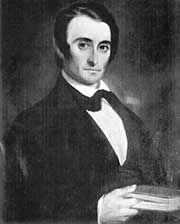 |
|
|
William
Mills—
‘The
Yellow Springs man’
Judge William Mills, whose beloved estate once stood at the center of
Mills Lawn, was not the first patron of Yellow Springs. Even his father,
Elisha Mills, who built up the spring resort, was not the first to draw
people to what is known today as Glen Helen. But Judge Mills may be considered
the village’s founder because of the determination he showed during
America’s thrust westward to make Yellow Springs a permanent place
of healthy commerce and national recognition.
At the beginning of the 19th century, a wealthy German entrepreneur from
Cincinnati named Martin Baum, a Greene County surveyor named Lewis Davis
and Davis’s brother-in-law Benjamin Whiteman, one of the county’s
first judges, purchased the area around the Yellow Spring and Miami Township.
The mythical appeal of the ochre-colored spring, which was said to cure
any ill, drew many of Baum’s wealthy acquaintances from Cincinnati,
who traveled by stagecoach lines to stay at Davis’s inn by the spring.
An early account of the area given in Mrs. S. V. Cox’s “The
Story of Whitehall” says that a settler from Cincinnati named Benjamin
Drake “described Xenia as a village whose loitering population gave
more evidence of content than commerce.”
“Independent, however, of the curative power of this water, a summer’s
visit to Yellow Springs has many charms,” Drake said. “The region
in which it is situated is cool and healthful, being elevated near a thousand
feet above New Orleans, and it has wild and romantic scenery with cliffs,
waterfalls, babbling brooks, and flowering prairies, and the pleasant
villages of Springfield, Xenia, Dayton, and Clifton within an afternoon’s
drive.”
In 1805, Thomas Fream was appointed the first postmaster of the area.
According to Cosmelia Hirst’s 1895 scrapbook, Fream owned a trading
post and general store north of the Glen on a hill near the Springfield
stage road and was said to have given Yellow Springs its name. The name
Ludlow appeared in this area’s postal records between 1817 and 1823.
However, it is unclear whether the postal routes referred to the village
or more specifically to the post office itself.
When the Connecticut lawyer Elisha Mills came east with his family to
Cincinnati in 1826, he read in a newspaper that the land around the Yellow
Springs was for sale. He bought the tracts including the Glen and Yellow
Spring, for $6,135, and by 1829 was advertising his auspicious “water
cure” spa, just a day’s ride north by coach from Cincinnati.
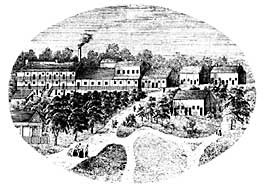 |
|
The old Neff House, which served as Mills’s
“water cure” spa in the Glen.
|
In contrast to the
show of wealth and leisure made by spa visitors, life for the 100 or so
local residents was modest and rugged. Jane Hill Baker references the
characteristics of the day for the 1830’s frontiers- men and women
in her 1974 thesis on William Mills. The general store not far from the
spring, she wrote, stocked only practical necessities such as yard goods,
powder and lead for hunting and some food items. Oats and corn cost 8
cents a bushel, eggs were 2 or 3 cents per dozen, pork went for $1.50
per one-hundred weight and whiskey was 15 cents a gallon. Bartering and
mutual labor was more common than using money. It took five days for the
mail to arrive from Washington, seven from New York.
It was in these times and circumstances, according to R. Straker in Horace
Mann and Others, that William Mills spent his formative years, walking
or riding on horseback to Springfield every week to study with Judge Torbet,
who later became Springfield’s first mayor. Mills studied classics
at Kenyon College in 1832 and then at Miami University, never graduating,
before becoming postmaster here in 1835. He was later known as Judge Mills
after settling several local disputes, though his formal training focused
on the classics.
Mills was interested in the industrial development of Yellow Springs,
according to Straker. By 1830, investors had realized the limitations
of canal transport and were just beginning to look toward the railway,
Baker wrote.
According to Baker’s thesis, the Mad River and Lake Erie (MR and
LE) railroad company procured a charter to complete a track from Sandusky
to Dayton in 1832. It was the first charter granted west of the Alleghenies.
In 1836, Mills traveled to Washington, D.C., to hear the Senate discuss
Henry Clay’s idea that the Treasury’s extreme surplus couldn’t
possibly be spent by the government and should be redistributed to the
states.
That same year the Little Miami Railroad company received $600,000 from
Clay’s Distribution Act and $200,000 from Cincinnati to connect the
southern terminus of the MR and LE line from Dayton to Cincinnati, thus
providing continuous transport from Lake Erie to the Ohio River.
Nine years later, in February 1845, the Xenia Torch Light reported that
the railroad had only been completed from Cincinnati to Xenia when the
Little Miami Railroad Company ran out of money. By the very next month,
the paper reported Mills was in the East negotiating a loan for the remaining
stretch of the railroad.
Mills tried to convince investors in New York that shortening the distance
between Lake Erie and the Ohio River to two days by rail would bring highly
profitable returns. He also appealed to their sense of competition with
Pennsylvania and Maryland, who might take all the benefits of western
trade right out of their hands.
Through the help of Nathan Hale, editor of the Boston Daily Advertiser,
on April 29, 1845, Mills got his loan for $500,000 to complete the railroad.
News articles from around this time indicate that Mills had likely also
met with the board of directors of the Little Miami Railroad and convinced
them to run the rails through Yellow Springs instead of its original route
through Clifton. According to a Xenia Women’s Club paper written
in 1942 by Lila Reed Jones, the village of Clifton was “then the
largest and most prosperous community in the Miami Township.”
“The loss of the railroad ruined a town with promising water power,”
enough for paper, wool, cotton, flour mills and a distillery, all running
full force, Jones wrote.
The MR and LE railroad opened in the late summer of 1846, and by 1859
gross profits had reached $1,200,510.
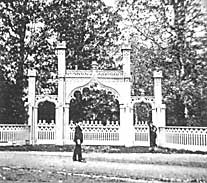 |
|
Entrance gate in the ornate fence surrounding
Mills Lawn, grounds of William Mills’s residence.
|
“When the word
went out that the Little Miami Railroad would pass this point it was the
signal that here would be a place for business, hence the rapid building
of the town,” Hirst wrote in her scrapbook. “In all directions
from early morning until late evening was heard the sound of the saw and
hammer. Every man was busy fitting up a place for his own special industry
and in making a home for his family or assisting others to do it. To supply
the needs of all these came the merchant and grocer, and by the time the
railroad was finished, in 1846, several hundred persons were located here
and modern Yellow Springs was well established upon the west side of the
stream.”
Instead of abating Mills’s sense of ambition, the railroad success
fueled the scramble to capitalize on an opportunity. In her thesis Baker
explores the character of many frontier entrepreneurs of the period and
finds that Mills was like other accomplished Americans in that he was
a community-minded risk taker, motivated by prestige, profit and social
responsibility. He “acted as an unabashed promoter or booster of
the community.”
To that end, Mills
sought to exploit natural resources such as timber and lime and to improve
roads for transporting goods to and from the railroad. According to Jones,
he built a three-story machine shop managed by Washington Shroufe and
“Pig” Thomas that processed “the whitest lime in Ohio.”
Farmland was being cleared, sawmills were producing lumber, brick was
manufactured from local clay deposits and the value of the land along
the railroad had risen to as much as $600 an acre, 30 times the average
price for farmland.
Mills advocated tirelessly in the local vicinity and in the surrounding
region for the advancement of Yellow Springs. In 1847 he attended a convention
in Chicago to discuss improving water transport, particularly at the Great
Lakes, where the Mad River and Lake Erie Railroad ended in Sandusky.
On the home front, Mills married Margaretta Poague of Spring Valley in
1840. Two years later his father deeded him the 600 acres of land that
was the village and the Glen.
Straker wrote that Elisha was mad at his son for choosing the swampy and
sometimes flooded center of town to build his grand home. But Mills landscaped
his estate with two small streams with rustic bridges and bark-covered
drives curving through from Limestone Street up to the house and over
to Elm Street, Hirst wrote.
Mills never hesitated when he recognized an opportunity. He would soon
be credited for establishing Antioch College in Yellow Springs and the
gravel-lined layout of the village road system. But his ambition would
carry him too far and eventually cause him to stumble.
Elizabeth Peabody, Baker wrote, once said: “I have in my journey
become acquainted with several of those men who stand as Father of the
Future Age: William Logan Fisher; William B. Ogden; William Mills (the
Yellow Springs man).”
—Lauren
Heaton
The
Owenites: the first of the dreamers
Is it something in the water?
Whatever the reason, for 200 years, Yellow Springs has attracted more
than its fair share of freethinkers, dreamers and radicals.
The area’s first official group of nonconformists may have been the
Owenites, a commune of about 100 families who lived in what is now Yellow
Springs from 1825 to 1826.
The group favored the ideals of Robert Owen, a Welsh laborer who became
a wealthy industrialist in Scotland. After creating a model community
in Scotland founded on his “humanitarian and socialist beliefs”
he decided that America, with its new frontier and new ideals, provided
the perfect setting for a larger community based on his principles.
“I am come to this country to introduce an entirely new system of
society; to change it from an ignorant selfish system to an enlightened
social system which will gradually unite all individuals into one and
remove all causes for contest between individuals,” he said, according
to a history of the group by Don Hutslar.
Wealth and property should be divided equally among everyone in a community,
said Owen, who journeyed from Scotland to Cincinnati in 1824, attempting
to attract recruits. While some of his followers set off with Owen to
New Harmony, Ind., another group, led by Daniel Roe, minister of the New
Jerusalem Church, purchased 729 acres of land about 70 miles north of
Cincinnati, including the acclaimed medicinal waters of the Yellow Spring
and the area that encompasses the current village.
The Yellow Springs group consisted of highly educated and professional
people, “intelligent, liberal, generous, cultivated men and women,”
according to an article in Noyes’ History of American Socialism.
The Owenites set about to construct a shelter near the Yellow Spring,
according to a 1926 letter written by S.W. Cox. “On the west bank
of the cascade, a short distance back, they built a long, rambling house
of split logs. . . The interior was divided by the same type of crosswise
partitions into rooms with a fireplace; each room accommodated one family.
The community kitchen and dining room was of double size, at the north
end of the building.”
The Owenites were long on dreams, but short on practical experience in
working and living together, which may have led to their downfall.
“Men who seldom or never before labored with their hands, devoted
themselves to agriculture and the mechanic arts, with a zeal which was
at least commendable, though not always according to knowledge,”
according to Noyes. “Ministers of the gospel guided the plow; called
the swine to their corn, instead of sinners to repentance. . . Among the
women, there was even more apparent self-sacrifice. Ladies who had seldom
seen the inside of their own kitchens, went into that of the common eatinghouse,
and made themselves useful among pots and kettles.”
Within months, however, members of the group began arguing and forming
competing factions, according to R.S. Dill’s The History of Greene
County. “Too soon did the majority assume to be leaders, and issue
commands, while an insignificant minority did the work,” Dill wrote.
The Yellow Springs Owenites disbanded a year after they came together,
although the log structure they built remained standing for many years,
with the foundation still visible almost a hundred years later.
—Diane
Chiddister
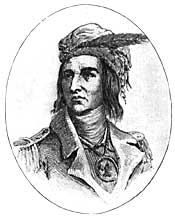 |
|
Tecumseh, leader of the Shawnee
|
Tecumseh
and the spring
Imagine, if you will, going back in time 200 years and, on a trip to the
Yellow Spring in Glen Helen, meeting one of history’s most distinguished
Native American leaders.
Tecumseh, leader of the Shawnee nation, would have been 35 years old in
1803 and was believed to frequent the local spring, which the Shawnees
thought held healing waters. Other famous chiefs, including Blue Jacket,
Blackhoof, Blackfish and Little Turtle, also drank water from the spring,
which was located just off the “Bullskin Trace,” a well-used
Native American path which extended from Lake Erie to the Ohio River,
according to William Galloway’s History of Glen Helen.
Tecumseh might have been traveling to his former home in Oldtown, then
called Chillicothe, the “thriving capital city of a diverse Indian
nation,” according to a September 1995 Xenia Daily Gazette article.
Though born in Chillicothe, by 1803 Tecumseh was probably living in a
settlement near what is now Greenville.
The Shawnee were well-acquainted with what today is called the Glen, and
the Cascades was the “favorite trysting place” of Shawnee lovers,
according to Galloway, who said that the “trace on both banks of
the stream from cascade to the tip of the ‘Meditation Point’
was their ‘Lover’s trail.’ ”
By the early 1800s, however, the growing presence of white settlers threatened
the Shawnee way of life.
Many whites feared the Native Americans or wanted their land, and in 1801
William Henry Harrison, then-governor of the Indiana territory, said that
“a great many of the Inhabitants of the Frontiers consider the murdering
of the Indians in the highest degree meritorious,” according to a
December 1987 article by David Edmund in Timeline.
Alcohol exacerbated the problems. “A flood of firewater poured into
Indian villages,” Edmund wrote. “Once-peaceful communities became
scenes of drunken violence. Debauched by alcohol, many tribesmen fell
victim to a series of epidemics that swept down the Ohio Valley at the
beginning of the nineteenth century and populations declined. Dissipation,
disease and hopelessness ruptured clan and family ties.”
No fighting between whites and Native Americans seems to have taken place
in the immediate vicinity of the Yellow Spring, and when the village’s
first white settler arrived, his life was probably relatively peaceful.
Lewis Davis of Dayton purchased land from Congress in 1803, and built
a home for himself and his family near the famous spring.
Davis also ran a tavern and traded with the Shawnee. He advertised the
“medicinal qualities of the spring water” in an 1804 Cincinnati
newspaper, according to Why They Came, a book published by the Yellow
Springs Community Council in 1956, commemorating Yellow Springs’
100th birthday.
“There are the most celebrated mineral waters in Ohio and beginning
to be much frequented,” Josiah Espy of Pennsylvania wrote in his
diary during a visit to the spring in 1805. “The Yellow Spring is
a beautiful, bold and limpid water . . . it is now most used in rheumatism
and eruptions of the skin, and with great efficacy.”
Davis sold his tavern to General Benjamin Whiteman the following year,
but continued to promote the healing aspects of the Yellow Spring. In
1812 he advertised lots for sale in Ludlow, the name given to the Yellow
Springs area at that time.
“The site of this place is dry, elevated and elegant; The air and
water are esteemed peculiarly salubrious. The town . . . is on a scale
the most liberal, and calculated to combine elegance of design with public
convenience. The streets, squares, court and public walks — all of
which are to be kept open forever — will afford a permanent and pleasing
diversity,” Davis wrote in the ad.
While whites were discovering the healing qualities of the Yellow Spring,
Tecumseh was traveling throughout the region, attempting to forge bonds
between tribes in Ohio, Indiana and Illinois in an effort to fight the
growing loss of their land. A powerful orator, Tecumseh was also notable
for his humane treatment of prisoners, according to Edmund.
Tecumseh’s attempts to solidify a Native American confederacy gained
him notoriety among American commanders and he “loomed as a serious
menace to further American expansion,” Edmund wrote.
In a last attempt to halt American encroachment, Tecumseh’s warriors
and the British fought Americans at the Battle of Thames in Canada in
1813. Tecumseh died on the battlefield.
Tecumseh “was a brave and honorable man,” Edmund wrote, who
sacrificed his life for his people, “dying a hero’s death in
the last great battle for the Old Northwest.”
—Diane Chiddister
Installment
2: 1853 to 1868
The
Civil War years—
From
the battlefield to ‘the Springs’
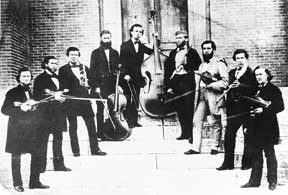 |
|
PHOTO courtesy of Antiochiana
The Camprymolians Music Organization at Antioch in 1858. Marion
Ross, bass viol player, center, was later hanged in Atlanta by the
Confederates, who captured him in the celebrated locomotive chase,
known as the ‘Andrews Raid,’ during the Civil War.
|
Ohio saw no such battle
as Gettysburg or Antietam on its soil during the Civil War. But its residents
played an important role for the Union by sending a great many men to
the battlefields and supporting them with supplies and frequent correspondence
as they fought against the Confederacy.
Yellow Springs and Antioch College did their part, and within a week of
President Lincoln’s call for volunteers for the Union Army in 1861
at least 16 young men were packing their bags for the cause.
Local resident Oscar Derostus Ladley was one of those men. Letters between
him and his family during this tumultuous time survived and were compiled
in 1988 into Hearth and Knapsack: The Ladley Letters, 1857–1880.
They tell the story of a dutiful soldier on the move and his hardworking
mother, Catherine, and his two younger sisters, Mary and Alice, who waited
out the war at home in Yellow Springs.
Ladley was 23 years old when the war’s first shots were fired at
Fort Sumter in 1861. He had attended Antioch’s preparatory school
and was clerking in a local dry goods store, as well as serving as the
head of the household since his father’s death in 1858. According
to an Antioch College news bureau report compiled for the college’s
centennial in 1953, Ohio was generally an antislavery state, though most
thought slavery acceptable in the South. Yellow Springs, with its proximity
to the border state of Kentucky, was no exception.
Ladley enlisted as a private in Company E of the 16th Ohio Volunteer Infantry
Regiment and from his first day at Camp Jackson in Columbus in May 1861
began a lifetime of weekly missives that opened, “Dear Mother &
Sisters.” He sent the war home to a relatively calm Yellow Springs,
detailing the men he fought beside and the food they ate as well as their
living quarters and battlefield scenes.
He describes a skirmish against the “Southern rebels” around
Virginia’s second Battle of Bull Run in the summer of 1862: “It
was one continual buz of ball past me all the time, some would go over
my head, others all round and others plow up the ground at our feet, one
struck the sole of my shoe and cut the leather, but no other damage was
done me.”
He reported home on the rest of the “Yellow Springs Boys” and
sent almost all of his monthly pay, $20, to his family, along with trailside
souvenirs of petrified wood, rings of laurel root and tattered pieces
of the national colors. And he inquired often about the news “at
the Springs,” always telling his family to “remember me to Augusta
Mills and the rest of the ladies.”
The local boys on the battlefields certainly included those from Antioch
College. Marion A. Ross had only been a student at Antioch for a year
when he joined the Union Army.
He writes in a letter to Colonel Joseph Wilson from Camp McClelland in
Philadelphia in May 1861: “Everybody is willing to do something for
the soldiers. We have thousands of the best friends wherever we have been.
For my part, I passed about 25 hours without food, and can go double that
and then feel willing to fight. We must be willing [to] endure hardships,
without complaint.”
By 1862, Ross was a sergeant major of the Second Ohio Volunteer Infantry.
In April 1862, Ross volunteered with 21 other men for a daring expedition
to capture Southern rail lines that became known as the famous Andrews
Raid. General J.J. Andrews and his men seized a locomotive known as the
“General” at Big Shanty, Ga., on April 12 and ran it north toward
Chattanooga, Tenn., destroying telegraph lines along the way. But they
were soon caught by Confederate troops and seven of them, including Ross,
were hanged.
The Antioch news bureau reported Ross’s last words to his company:
“Tell them at home if any of you escape, that I died for my country
and did not regret it.”
According to a paper on the early history of Yellow Springs by Phyllis
Lawson Jackson, Robert Bachelor was the first soldier from Miami Township
killed in the war and John Lordingly was the first wounded.
Meanwhile on the home front, the Ladley family remained enthusiastic about
writing faithfully to Oscar about the goings on in town. They held a benefit
dinner for the soldiers, where 15-year-old Alice wrote they raised $100
and had “ice cream tables and oysters and everything nice.”
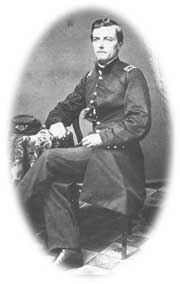 |
|
Local resident Oscar Ladley enlisted as a private
in the Union Army at the start of the Civil War. He eventually was
promoted to first lieutenant of Company G, 75th Ohio, and was one
of only two 75th Ohio officers at Gettysburg to escape the battle
unharmed. Photo from ‘Hearth and Knapsack: The Ladley Letters,
1857–1880.’
|
The female students
at Antioch College were also contributing to the war effort. Irene Hardy,
a student at Antioch during the war, writes in her autobiography that
the women spent time during Greek or history classes knitting stockings
and scraping lint from old linen rags that would be used on wounded soldiers
to stop the bleeding. They filled boxes with bandages and food such as
sauerkraut and onions to be sent to the soldiers by the local branch of
the Sanitary Commission.
It was hard for soldiers such as Ladley to remember while on the front
lines that the people at home were doing what they could to help the war
effort. He writes to his family in mid-August 1862, after almost a year
and a half of backpacking with upwards of 50 pounds of equipment and marching
into grueling hand-to-hand combat: “I think if some of the [young
ladies] could stand at a distance and witness a hard battle and see the
horrors of the battle field they would think of us oftener perhaps than
they do.”
Mary Ladley, who was 17 in November 1862, fancied herself in her brother’s
position in the ranks, writing: “I don’t see how you can keep
from freezing. Blame the rebels, I say. I wish they were all in the bottom
of the sea. If I was a boy wouldn’t I fight though.”
But life carried on in Yellow Springs, with Mary looking for a position
as a school teacher and Alice helping her mother take care of the college
boarders the family took in for extra money. And they continued to report
the news.
At the close of 1862, Mary wrote to her brother that the Yellow Springs
Water Cure had burned down and that Antioch students had cut the college
bell rope and greased the blackboards. Several months later, she wrote
that professor Doolittle’s cow had been put in the college cellar,
and that “the next morning he was all over town looking for his cow.”
The family showed no sympathy for the Southern sympathizers known as “copperheads”
or “butternuts,” but they and others did not think that African
Americans belonged at Antioch. In the “Story of Whitehall Farm,”
S.V. Cox describes Aaron Harlan, the builder of Whitehall and an Ohio
senator from 1852–1861, as an ardent abolitionist who nevertheless
as an Antioch trustee was against admitting blacks to the college.
While Antioch held steadfastly to its charter stating that students should
be admitted “without the distinction of race,” according to
a student history paper written by Ronnie Perkins in 1959, many donations
were lost because of this policy. And according to a letter written by
Mary Ladley in April 1863, several Antioch students left school in protest
of a black girl who was admitted to Antioch.
“They have been having a big time here at Antioch,” Mary wrote.
“There was a colored Lady come here from Oberlin to go to school.
The students kicked up a fuss. They got a petition to put her out. . .
The Faculty have refused and about ten or twelve of the students have
left. I think it is too bad the ‘niggers’ can’t stay where
they belong.”
The loss of donations and tuition from many college-age men who were serving
in the war forced Antioch to close its doors in 1864, though the prep
school remained open. Perkins reported that while the Christian Church
which founded Antioch failed to rally enough funds to save the college,
Antioch was able to open its doors again in 1865 due in large part to
an endowment fund of $100,000 raised by the Unitarian Church.
The war sputtered to an end in the spring of that year when General Ulysses
S. Grant overtook General Robert E. Lee’s army in Virginia.
Two decades later, Antioch College held a memorial service to dedicate
a plaque bearing the names of 33 students who died in service of their
country. At the dedication J. Warren Keifer, an Antioch alumnus who attained
the rank of general in the army, said, “The tablet placed here is
to commemorate the lives and perpetuate the names of those, who, in the
earliest days of Antioch College, while in pursuit of knowledge, to fit
them for life and eternity, mustered in these halls; then a little later
on fields of tumultuous war’s wild carnage, and who now muster beyond
the grave in that great army of immortals, called, ‘died for their
country.’ ”
Oscar Ladley survived the war and came back to Yellow Springs, only to
find it had become what he called a “lethargic” village with
few employment opportunities. He joined the army again and moved across
the U.S., writing to his family until his death in New Mexico in 1880.
—Lauren
Heaton
Long
road to incorporation of village of Yellow Springs
In 1844 the area now known as Yellow Springs was little more than a wilderness,
with only a handful of buildings to break up the vast expanses of forest.
The popularity of the resorts around the Yellow Spring had begun to decline,
and the few residents who called the area home were left to search for
a way to bring new economic and social life to the settlement.
It was in 1844 that William Mills used his fundraising skills to persuade
the Little Miami Railroad to change its planned Xenia to Springfield route
to run through Yellow Springs instead of Clifton.
When the railroad was completed in 1846, the settlement of Yellow Springs
had been re-energized by the three trains that completed a daily circuit
from Cincinnati to Springfield. Freight from the Clifton mills and factories
and limestone from a quarry near what is now the Antioch College power
plant helped fuel the settlement’s fledgling economy, and by the
late 1840s many merchants had set up shop in what today is downtown Dayton
Street. These early shops included a clothing store, a depot store and
a “cheap cash store.” In the block of town that now hosts Peach’s
Grill and the Gypsy Cafe, Mills and A.C Johnson erected a general store
that sold food and dry goods.
By the time Antioch College opened its doors in 1853 the settlement was
already home to between 1,000 and 1,500 residents according to several
sources, and the Xenia Torch-Light reported that local residents were
bidding to make Yellow Springs Greene County’s “first town.”
Over 50 houses were built in the settlement in the summer of 1852, and
by 1853, four churches and an antislavery society were established and
growing in the town.
In fact, petitioners received an order of incorporation on May 7, 1853,
but that petition was annulled a week later on May 16. That original petition
was brought by Mills, William Huffman and Isaac Kershner, the settlement’s
first postmaster. Judge William Rodgers ordered the annulment after hearing
a complaint by William Neff, the operator of the big hotel by the Yellow
Spring.
The failure of the first attempt to incorporate the settlement did not
seem to discourage Mills. Before 1853 had expired Mills had platted a
village of 436 lots and 37 streets, six of which were over one mile in
length. Mills even went so far as to have the streets graded and graveled
at his own expense. The graveling of the streets did not come without
criticism though. According to “Yellow Springs, 1846–1864,”
a history thesis by Joel Samoff, Aaron Harlan, the first president of
the Antioch College Board of Trustees and the owner of Whitehall farm,
told Mills, “For goodness sake, Mills, don’t gravel all those
streets, they’ll be hard to plow through.” Harlan, who was also
a member of the U.S. House of Representatives, thought that the town would
never grow to the size Mills expected, and that many of the roads would
eventually be covered by cornfields.
A second attempt to incorporate Yellow Springs was made, but was apparently
unsuccessful, the News reported in its centennial section.
Mills remained determined to see the settlement become a village, and
in 1855 he plotted 112 more lots, and began to advertise them at prices
from $150 to $500. In 1856 Mills and E. Stewart led a group of over 125
residents in another effort to petition for incorporation.
On Feb. 18, 1856, the petition was accepted by the Greene County commissioners,
and Yellow Springs became a village. Commissioners John Sudge and John
Little signed the order that included the following passage:
“We the undersigned being a majority of the commissioners . . . being
satisfied that
. . . 160 qualified voters actually reside in the limits described in
the petition, that said petition has been signed by a majority of qualified
voters . . . it being deemed right and proper . . . that said petition
should be granted. It is hereby ordered that the said incorporated village
. . . may be organized.”
Following the incorporation, Yellow Springs continued to grow and prosper.
In 1857, 180 more lots were added to the village. Thanks in part to the
growth
of Antioch, Yellow Springs became known for hosting political rallies
and various
well known speakers from the lyceum circuit. Some of the lecturers who
visited
the town in its
early days included Ohio Governor Salmon P. Chase, Horace Greely, Charles
Sumner, Theodore Parker and Wendell Phillips, according to Samoff.
The first entry in the local village council books records the incorporation
and the boundaries of the town. But it appears that no further entry was
made in the council record until 1861, the News reported in a special
section celebrating the centennial of Yellow Springs. There is some debate
about whether or not the council actually met between ’56 and ’61.
Although there are no council records, “The Compass of Life,”
a periodical published in Yellow Springs in the 1850s, states that on
Oct. 6, 1858, the town passed an ordinance “to provide against the
evils resulting from the sale of intoxicating liquors to minors unless
upon written orders of their parents, guardians, or family physicians.”
The seven-section ordinance also said that those granting the permission
of the disbursement of alcohol should “not be in the habit of getting
intoxicated.”
Isaac Kershner, who served as postmaster from 1853 to 1859, was the first
mayor, serving one year. According to Broadstone’s History of Greene
County, the other early mayors were Andrew Shroufe, ’57; J.W. Hamilton,
’58–’59; Hezekiah Davis, ’60; A.B. Wambaugh, ’61;
J.W. Hamilton, ’62–’63; F.D. Leonard, ’64; and E.M.
Birch, ’65.
—Brian
Loudon
The
journey of the Conway Colony
In the midst of the Civil War during the summer of 1862, a train arrived
in town carrying the Rev. Moncure Daniel Conway
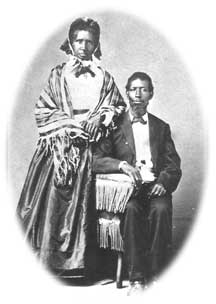 |
|
PHOTO courtesy of Antiochiana
Eliza and Dunmore Gwinn, freed slaves who arrived in Yellow Springs
in 1862 with Moncure Conway. They were considered patriarchs of
the Conway Colony.
|
and a group of liberated
slaves. Conway brought the slaves, who were from his family’s Virginia
plantation, to Yellow Springs, where he believed they could start new
lives and prosper as free men and women and children.
The pastor of the First Congregational Church of Cincinnati, Conway, an
abolitionist whom Scott Sanders, the Antioch University archivist, calls
a “maverick,” was visiting in Yellow Springs — where he
had friends — when he learned that the slaves had fled the plantation
when the Union Army marched past Falmouth as fighting raged around Fredericksburg.
Conway left at once, hoping to bring the slaves back to Yellow Springs.
He found two of his father’s slaves, Eliza and Dunmore Gwinn, in
Washington D.C.’s Georgetown neighborhood, where they had set up
a candy store. Conway then found many of the other plantation slaves at
the home of an escaped slave who was active in the Underground Railroad,
Sanders wrote in an article for the Yellow Springs Historical Society
published by the News a few years ago.
Conway and his group, including the Gwinns, then set out by train for
Yellow Springs. It was a sleepless and perilous journey.
In the volatile city of Baltimore, the group had to walk to another station
to change trains. “The sensation we caused was immediate,” Conway
wrote. As the group proceeded, they attracted the attention of African-American
citizens, who at first thought the colony members were freed slaves returning
to slavery. But when they learned that the colony was heading to Ohio,
the crowd began to cheer, attracting an “even larger mob of hostile
whites,” Sanders wrote. “Conway somehow held them off during
a tense three-hour wait for a train.”
Eventually the group boarded a train during the night and headed west.
In his autobiography, Conway wrote that the slaves “would neither
talk nor sleep. They were yet in a slave state, and every station at which
the train paused was a possible danger.”
When the train crossed into Ohio, and freedom, “a great celebration
erupted,” Sanders wrote.
The exact number of slaves who traveled with Conway is unclear. Sanders
said that either 30 people or 30 families made the arduous journey. Jean
McKee, whose great-great-great-grandmother Julia made the journey, and
who has extensively researched her family’s history, said that between
30 and 60 people came to Yellow Springs. An article on the Conway Colony
published last year in The Free Lance-Star, in Fredericksburg, Va., reported
the number as 31.
Both McKee and Sanders said that Conway chose to bring the colony members
to Yellow Springs because he knew they would be accepted here.
When they arrived, the colony members first stayed in a barn owned by
Moses Grinnell, a prosperous local miller. Some eventually bought land
and built homes, while others rented. The Gwinns owned property off what
is now called Grinnell Road. When Conway returned to the village in 1875,
Sanders wrote, he observed that Dunmore Gwinn “had a good house,
five well-kept acres, poultry and pigs; he and his family were the coloured
gentry of the region.”
McKee, who lives in Cincinnati, described the freed slaves as a hardworking,
religious group. It appears that Conway’s mother taught the Bible
to the slaves on the plantation, said McKee, the daughter of Naomi and
Jim McKee, the former police chief who died in January. The men farmed
or worked as farm laborers, and the women did domestic work at the hotel
or in other people’s homes. Eliza worked as a domestic, while Dunmore
sold produce he grew.
Members of the colony, including the Gwinns, were “instrumental in
starting” the Anti-Slavery Baptist Church, which today is the First
Baptist Church, McKee said.
Richard Herod, a son-in-law of Eliza and Dunmore, volunteered with the
Union Army, serving as a private in the U.S. Volunteers Colored Heavy
Artillery unit. After the war he became an ordained minister in the Baptist
Church and worked at the hotel. None of the other members of the colony
served in the war, McKee said.
Many colony members eventually left town after coming to Yellow Springs,
though the Gwinns lived here until they died. Their children who made
the journey or followed later may have spread out after arriving here,
McKee said, though Julia, who was Dunmore’s sister, lived here until
she died in 1871. Julia’s husband, Charles Morgan, left after she
died, McKee said, and her daughter Evaline lived in town until her death
in 1890. Eliza died in 1889 at the age of 76; Dunmore died eight years
later in 1897 when he was 84.
McKee said that she has not been able to determine what happened to the
other families.
That the Gwinns stayed in Yellow Springs until they died, McKee said,
showed their commitment to the community.
—Robert
Mihalek
Full
of ideas, Antioch struggled from its start
Short on cash but long on dreams.
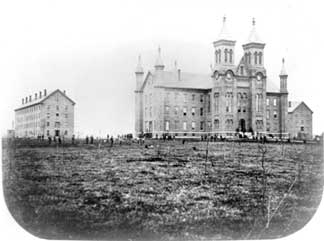 |
|
photo courtesy of Antiochiana
Taken circa 1860 by an unknown photographer, this is the earliest
known photo of Antioch College and shows people planting trees,
likely as part of President Thomas Hill’s tree planting efforts.
It also features South Hall, the ‘Gents dorm,’ left, Antioch
Hall and North Hall, the ‘ladies dorm.’
|
You could say this
description fit Antioch College from the get-go. And Oct. 5, 1853, might
be considered the get-go, for on that day the college inaugurated the
renowned educator Horace Mann as Antioch’s first president.
The event drew 3,000 people from across the country, eager to hear the
famous Mann speak, Mann’s wife, Mary, wrote in a letter to her father,
and the town overflowed with so many visitors that many had to sleep in
their buggies the night before.
Dreams ruled the day. Mann, a powerful orator and an imposing figure with
his abundant white hair and piercing blue eyes, laid out in his inaugural
address his vision of Antioch College as the savior of young minds in
the West, the nonsectarian “Great Experiment” that would encourage
freedom of thought and expression.
“We mean to administer this college as a literary and Christian institution,
where the mind is to be replenished with knowledge; where the affections
are to be trained to duty; where all the faculties of the soul are to
be devoted and urged on to the acquisition of truth,” said Mann,
according to Robert L. Straker’s The Unseen Harvest, Horace Mann
and Antioch College.
The crowd noisily expressed its appreciation, according to Mary Mann.
“I shall not soon forget the sea of eager upturned faces which met
my view from that platform, or the drinking-in expression with which old
and young listened to the Inaugural,” she wrote. “They have
a way here of groaning out ‘Amen’ in a true Methodist style
when they like anything. It issued from their lungs in various keys and
with various gradations of fervor as he went on, and when we came out
many persons accosted him and expressed their gratification.”
But the college’s cash shortfall also colored the event.
First off, construction had lagged behind schedule, partially due to escalating
bills, so visitors had to traipse through the mud. And while workers had
completed the magical towers of the main building, Antioch Hall, scaffolding
still hugged the sides. One dorm, North Hall, was complete, but a second
dorm and the president’s residence wouldn’t be finished for
a year.
During the ceremony, college officials worked the crowd for donations,
according to Mary Mann. “Mr. Phillips begged money in the most impressive
and witty manner,” she wrote, “and at last proposed that all
who wished to give, from the five hundred dollar men down to the three
cent men, should ascend the steps of the platform and put it down on the
table.”
Antioch raised $600 on the spot.
You could say that Antioch’s 150-year- old cash flow problems were
rooted in its dreams, especially its organizers’ dream of a nonsectarian
college.
Three years before Mann’s inauguration and the college opened its
doors, the vision of Antioch was born in Marion, N.Y., at a convention
of the Christian Connexion, a loosely organized group of 521 ordained
ministers. The Christian Connexion ministers represented former Baptists,
Presbyterians and Methodists who had splintered off from those bodies
and were more liberal than many of their brethren, according to Straker,
who wrote that the group was sometimes associated with the Unitarians.
However, the group was actually considerably more conservative than the
Unitarians, and rooted their doctrine firmly in the Bible.
At the Marion convention, the group decided to start its own college.
While many representatives preferred a sectarian college, a liberal subcommittee
gained control and set about making Antioch College, alone among colleges
in the West, unaligned with any specific religious group.
That move attracted the organizers’ first and only choice as the
new college’s president, and organizers were astonished when Mann,
a former Massachusetts legislator and the country’s best known educator,
accepted their offer, according to Straker. While Mann’s friends
questioned his decision to move at the age of 56 to the uncivilized wilds
of Ohio, Mann passionately believed in Antioch’s nonsectarian mission.
A deeply religious man himself, Mann held that church-sponsored colleges
offered inferior educations.
“In all this great West,” he said of Antioch College, “ours
is the only institution of a first-class character, which is not, directly
or indirectly, under the influence of the old-school theology.”
While nonsectarianism brought to organizers a first-rate president, it
also brought Antioch financial problems, according to Strater. Because
it was “a college without a constituency,” and had no official
institutional sponsorship, it opened without the endowment that sectarian
colleges took for granted.
Actually, the ministers had raised a small endowment of $50,000, but that
money vanished thanks to the college’s builder, Alpheus Merrifield,
said Scott Sanders, the Antioch University archivist. A conservative member
of the Christian Connexion, Merrifield had been left largely unsupervised
to construct the Ohio college. Angry that the college lacked a religious
sponsor, he squandered the endowment funds by refusing to keep financial
records and by building a larger campus than organizers had planned, Sanders
said.
Along with nonsectarianism, Horace Mann was also attracted to Antioch’s
policy of educating women and men. While several Midwestern colleges had
opened their doors to women, most offered women a watered-down education,
such as the “Ladies Department” of Oberlin College, which taught
only religion, French and literature, according to “The Trouble with
Coeducation: Mann and the Women at Antioch, 1853–1860,” by John
Rury and Glenn Harper. In contrast, women at
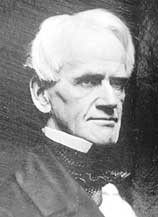 |
|
photo courtesy of Antiochiana
Horace Mann served as the first president of Antioch College, from
1853 until his death in 1859.
|
Antioch studied the
same courses as men.
So on Antioch’s Inaugural day, the college’s first class of
eight freshmen included two women, Jane Andrews of Massachusetts and Mahalah
Jay of Yellow Springs. The other students hailed from Pennsylvania, New
York, New Hampshire and Maine. While more than 1,000 young people had
applied to the college and 150 took the entrance exams, only eight passed,
according to Straker.
When classes actually began, Antioch, under Mann’s leadership, developed
the reputation as “having a curriculum similar to the best colleges
in the East,” Robert L. Straker reported in “A Brief Sketch
of Antioch College, 1853–1921,” and offered Latin, Greek, mathematics,
English, history, philosophy and science. Some educators criticized Mann,
however, for emphasizing the sciences at the expense of the classics.
“The educational foundation was intended to be broader, the cultural
aim higher than in any other college in America,” Straker said.
While Mann championed equal educational opportunities for both women and
men, he in no way encouraged intermingling between the sexes. Worried
that proximity of the sexes would lead to women’s moral decline,
Mann established a policy that women and men could only visit the Glen
on alternate days. A visit to a room of a member of the opposite sex was
punished by immediate expulsion, and women and men were “not permitted
to walk or ride together off campus unless accompanied by a faculty member,”
according to Rury and Harper.
A progressive thinker, Mann was nonetheless a product of his times. He
was in no way a proponent of equal rights for women and men and he and
his wife both looked down on feminists, whom Mary Mann called “the
ultra sorts.” And while women studied the same courses as men at
Antioch, they were not allowed to speak extemporaneously or from memory,
which was considered unwomanly, Sanders said.
However, an early, prominent student named Olympia Brown challenged that
restriction.
“When called before the class to recite a paper, she instead delivered
a stirring oration with the manuscript rolled tightly in her hand,”
Sanders wrote in “More of the Glorious, Spurious, Hilarious History
of Antioch.” “Her bewildered professor had no idea how to stop
her from memorizing her papers, and no one else did either.”
After Olympia Brown graduated from Antioch, she went on to become the
country’s first female ordained Universalist minister.
The college’s financial problems only grew worse, and during the
last three years of Mann’s presidency, the college’s debt ran
to $5,000 out of a $13,000 total budget. In 1857, the college went bankrupt,
although it continued to function. In April 1859, Francis Palmer, a college
trustee, purchased the college for $40,000 at auction.
Mann’s beloved college’s financial woes took a toll on his health.
In 1859, just a few months after he proclaimed to Antioch graduating seniors
to “Be ashamed to die until you have won some victory for humanity,”
Mann died in his home.
Antioch’s second president was Dr. Thomas Hill, a Unitarian minister
who Straker said was considered “one of the most brilliant of Harvard’s
graduates.” A classicist and mathematician, “his big blue eyes
and rather long blond hair, along with his absorption in his own thoughts,
gave him the appearance of a child,” according to the autobiography
of Irene Hardy.
According to Hardy, Hill was “so simple and democratic in his daily
life that he thought it not beneath the dignity of a college president
to mow grass in his shirt sleeves on the campus, when he wished to, between
lectures.”
Under Hill, the college maintained high academic standards, but its financial
problems continued, so that he was not paid his full salary and had to
borrow to meet expenses. Likewise, Straker wrote, “the college was
kept open only through the loans of friends.”
Religious politics continued to work against Antioch. While Hill attempted
to raise money for an endowment, he found that prospective donors, some
of whom were Unitarians, were put off by the school’s requirement,
developed by the Christian Connexion, that 12 trustees be Christians and
8 Unitarians. While Hill suggested that the numbers be equal so that the
board was comprised of eight Christians and eight Unitarians, the Christian
Connexion refused.
While the Christians feared the Unitarians wanted to take over Antioch,
Hill attempted to reassure them that the Unitarians wanted instead a genuinely
nonsectarian college. In a 1861 contract between the Christian and Unitarian
trustees, the Christians were given the first opportunity to raise the
money to pay off the college’s debts. However, they failed to do
so.
In June, 1862, Hill announced his resignation, and went on to become the
president of Harvard College. Austin Craig, a Christian minister and former
Antioch faculty member, was selected as the third president of Antioch
College.
In 1864, the Christians voted to close the college until necessary funds
were raised, according to Straker.
In 1865, organizers voted to remove the sectarian test for trustees. Shortly
thereafter, Unitarians approached the board to announce that $100,000
had been raised for the college in two months for a permanent endowment
for the college.
—Diane
Chiddister
|



